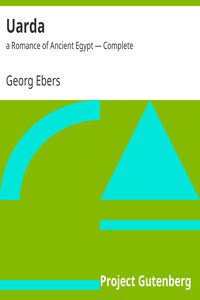Uarda : a Romance of Ancient Egypt — Complete, Georg Ebers [motivational novels .TXT] 📗

- Author: Georg Ebers
Book online «Uarda : a Romance of Ancient Egypt — Complete, Georg Ebers [motivational novels .TXT] 📗». Author Georg Ebers
“Nanine? (by Voltaire, 1749). What sort of title is that? What thoughts does it awake? Neither more nor less than a title should arouse. A title must not be a bill of fare. The less it betrays of the contents, the better it is. Author and spectator are both satisfied, and the ancients rarely gave their comedies anything but insignificant names.”
This may be the case with “Uarda,” whose character is less prominent than some others, it is true, but whose sorrows direct the destinies of my other heroes and heroines.
Why should I conceal the fact? The character of “Uarda” and the present story have grown out of the memory of a Fellah girl, half child, half maiden, whom I saw suffer and die in a hut at Abu el Qurnah in the Necropolis of Thebes.
I still persist in the conviction I have so frequently expressed, the conviction that the fundamental traits of the life of the soul have undergone very trivial modifications among civilized nations in all times and ages, but will endeavor to explain the contrary opinion, held by my opponents, by calling attention to the circumstance, that the expression of these emotions show considerable variations among different peoples, and at different epochs. I believe that Juvenal, one of the ancient writers who best understood human nature, was right in saying:
“Nil erit ulterius, quod nostris moribus addat Posteritas: eadem cupient facientque minores.”Leipsic, October 15th, 1877.
U A R D A.
CHAPTER 1.
By the walls of Thebes—the old city of a hundred gates—the Nile spreads to a broad river; the heights, which follow the stream on both sides, here take a more decided outline; solitary, almost cone-shaped peaks stand out sharply from the level background of the many-colored. limestone hills, on which no palm-tree flourishes and in which no humble desert-plant can strike root. Rocky crevasses and gorges cut more or less deeply into the mountain range, and up to its ridge extends the desert, destructive of all life, with sand and stones, with rocky cliffs and reef-like, desert hills.
Behind the eastern range the desert spreads to the Red Sea; behind the western it stretches without limit, into infinity. In the belief of the Egyptians beyond it lay the region of the dead.
Between these two ranges of hills, which serve as walls or ramparts to keep back the desert-sand, flows the fresh and bounteous Nile, bestowing blessing and abundance; at once the father and the cradle of millions of beings. On each shore spreads the wide plain of black and fruitful soil, and in the depths many-shaped creatures, in coats of mail or scales, swarm and find subsistence.
The lotos floats on the mirror of the waters, and among the papyrus reeds by the shore water-fowl innumerable build their nests. Between the river and the mountain-range lie fields, which after the seed-time are of a shining blue-green, and towards the time of harvest glow like gold. Near the brooks and water-wheels here and there stands a shady sycamore; and date-palms, carefully tended, group themselves in groves. The fruitful plain, watered and manured every year by the inundation, lies at the foot of the sandy desert-hills behind it, and stands out like a garden flower-bed from the gravel-path.
In the fourteenth century before Christ—for to so remote a date we must direct the thoughts of the reader—impassable limits had been set by the hand of man, in many places in Thebes, to the inroads of the water; high dykes of stone and embankments protected the streets and squares, the temples and the palaces, from the overflow.
Canals that could be tightly closed up led from the dykes to the land within, and smaller branch-cuttings to the gardens of Thebes.
On the right, the eastern bank of the Nile, rose the buildings of the far-famed residence of the Pharaohs. Close by the river stood the immense and gaudy Temples of the city of Amon; behind these and at a short distance from the Eastern hills—indeed at their very foot and partly even on the soil of the desert—were the palaces of the King and nobles, and the shady streets in which the high narrow houses of the citizens stood in close rows.
Life was gay and busy in the streets of the capital of the Pharaohs.
The western shore of the Nile showed a quite different scene. Here too there was no lack of stately buildings or thronging men; but while on the farther side of the river there was a compact mass of houses, and the citizens went cheerfully and openly about their day’s work, on this side there were solitary splendid structures, round which little houses and huts seemed to cling as children cling to the protection of a mother. And these buildings lay in detached groups.
Any one climbing the hill and looking down would form the notion that there lay below him a number of neighboring villages, each with its lordly manor house. Looking from the plain up to the precipice of the western hills, hundreds of closed portals could be seen, some solitary, others closely ranged in rows; a great number of them towards the foot of the slope, yet more half-way up, and a few at a considerable height.
And even more dissimilar were the slow-moving, solemn groups in the roadways on this side, and the cheerful, confused throng yonder. There, on the eastern shore, all were in eager pursuit of labor or recreation, stirred by pleasure or by grief, active in deed and speech; here, in the west, little was spoken, a spell seemed to check the footstep of the wanderer, a pale hand to sadden the bright glance of every eye, and to banish the smile from every lip.
And yet many a gaily-dressed bark stopped at the shore, there was no lack of minstrel bands, grand processions passed on to the western heights; but the Nile boats bore the dead, the songs sung here were songs of lamentation, and the processions consisted of mourners following the sarcophagus.
We are standing on the soil of the City of the Dead of Thebes.
Nevertheless even here nothing is wanting for return and revival, for to the Egyptian his dead died not. He closed his eyes, he bore him to the Necropolis, to the house of the embalmer, or Kolchytes, and then to the grave; but he knew that the souls of the departed lived on; that the justified absorbed into Osiris floated over the Heavens in the vessel of the Sun; that they appeared on earth in the form they choose to take upon them, and that they might exert influence on the current of the lives of the survivors. So he took care to give a worthy interment to his dead, above all to have the body embalmed so as to endure long: and had fixed times to bring fresh offerings for





Comments (0)